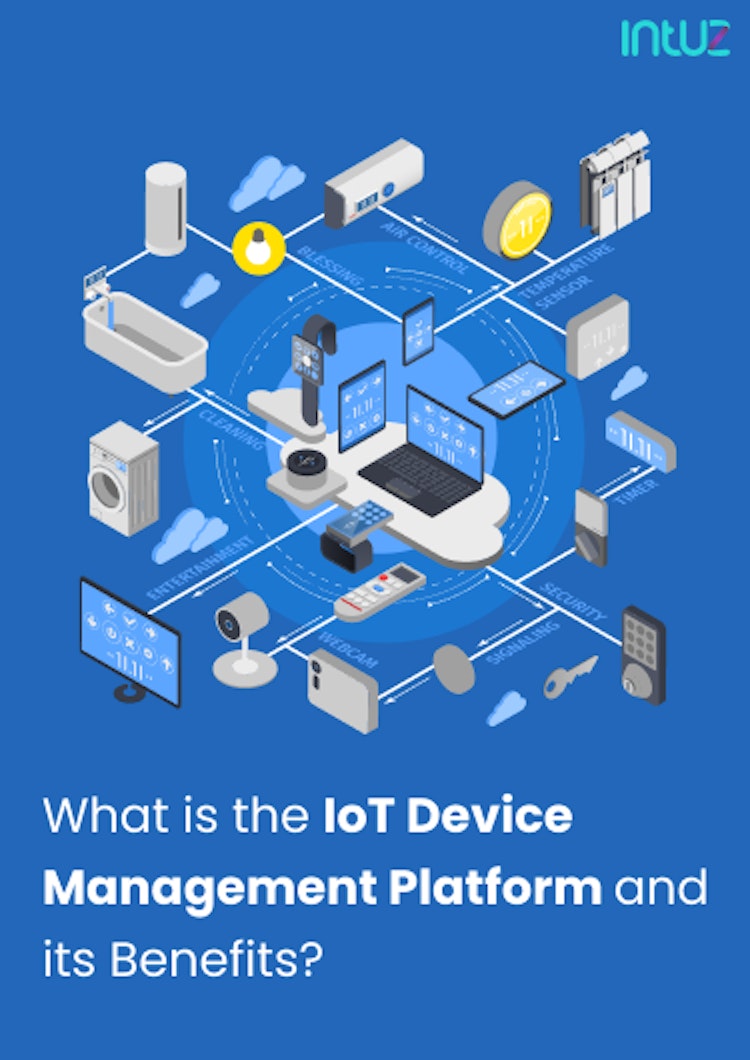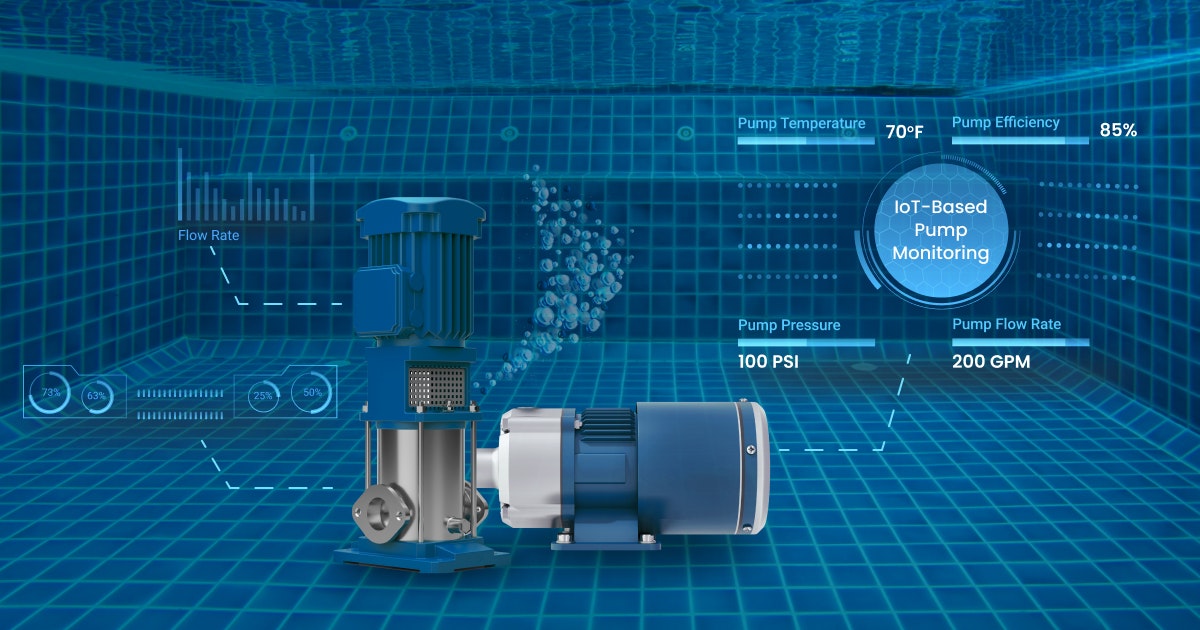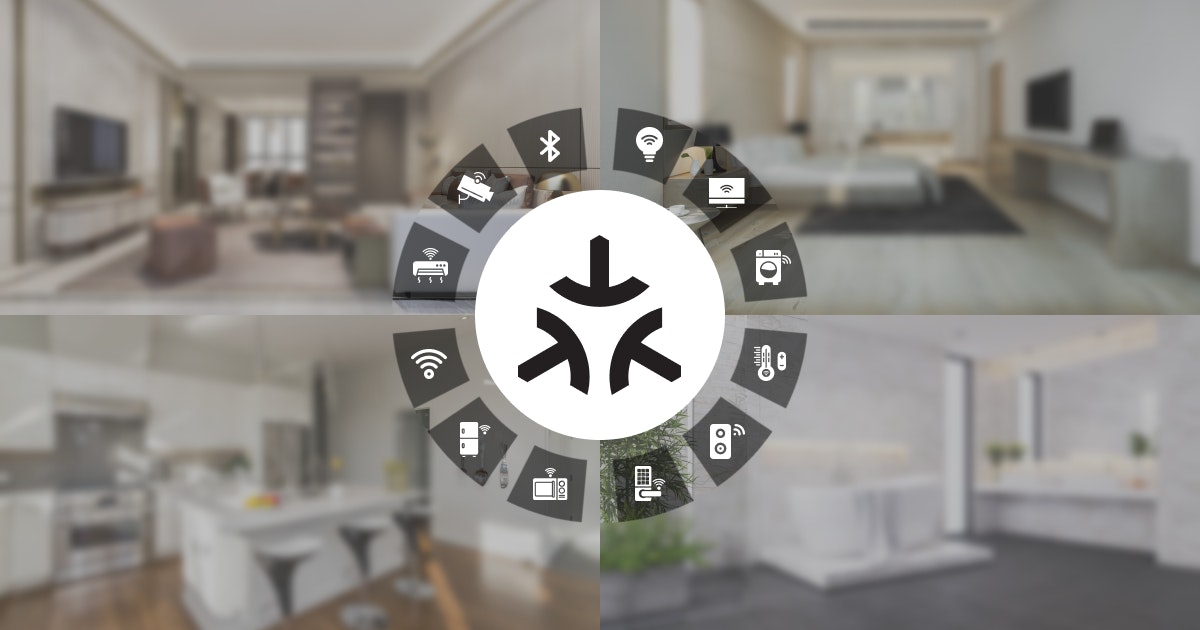Table of Content
With the increasing number of people working in hybrid setups, homes have undergone a significant transformation into intelligent and supportive spaces, made possible through the integration of smart home devices like smart light bulbs, speakers, video doorbells, security cameras, and more.
These devices form a comprehensive ecosystem, enhancing the functionality and convenience of our living spaces. According to eMarketer, as many as 64.1 million households in the US will actively use smart home devices in 2025.
While affordability continues not to be an issue, making the devices work is a daunting task. That is why using proprietary software and hardware that helps you bring all your IoT devices together is essential.
Meet the next-gen smart home protocol: Matter
One of the most significant breakthroughs in this sector has been the development of Matter. This open-source, royalty-free connectivity standard aims to provide a unified and secure foundation for the future of smart home devices.

Formerly known as Project CHIP (Connected Home over IP), Matter is backed by major industry players such as Apple, Google, Amazon, and the Zigbee Alliance. Its primary goal is to simplify the development and deployment of smart home devices, ensuring seamless Matter protocol integration and interoperability across different platforms and brands.
Popular wireless technologies used in smart home devices
From voice assistants to smart lighting and climate control, these devices utilize various wireless technologies to communicate and interact with each other and the user, including Zigbee, Z-Wave, WiFi, Thread, and Bluetooth.
Zigbee is a low-power wireless communication protocol that operates on a mesh network topology, enabling devices to communicate with each other and extend the network’s range. It operates smart light bulbs, door/window sensors, and smart thermostats.
Z-Wave is similar to Zigbee and is known for its compatibility and interoperability among smart home devices. It operates on a mesh network and offers low power consumption, allowing for extended battery life. Z-Wave is frequently used for smart locks, motion sensors, and garage door controllers.
Thread operates on a mesh network, where each device acts as a router, enhancing the overall network coverage and eliminating the need for a central hub. It is particularly well-suited for low-power devices, such as smart thermostats, door/window sensors, and light bulbs.
WiFi is perhaps the most widely recognized wireless technology in smart homes. It provides high-speed internet connectivity and allows the devices to connect to the home network, enabling remote control and monitoring capabilities. WiFi is suitable for devices requiring significant data transfer, such as streaming media, security cameras, and smart TVs.
Bluetooth is commonly used for short-range communication. It is ideal for connecting devices within close proximity, typically within the same room, allowing seamless streaming and control. Bluetooth is used for smart speakers, headphones, and mobile devices.
How do they compare against Matter?
Unlike Zigbee, Z-Wave, WiFi, Thread, and Bluetooth, which are individual protocols, Matter serves as a common language that enables seamless communication between devices, regardless of their underlying wireless technology.
By promoting device compatibility and ease of use, Matter seeks to overcome the fragmentation often associated with smart home devices and create a more cohesive and user-friendly smart home experience.
Factors to consider when selecting wireless technology
Whether your smart home project requires short-range wireless communication capabilities or long-range prowess, several factors must be taken into account before selecting the appropriate technology, including:
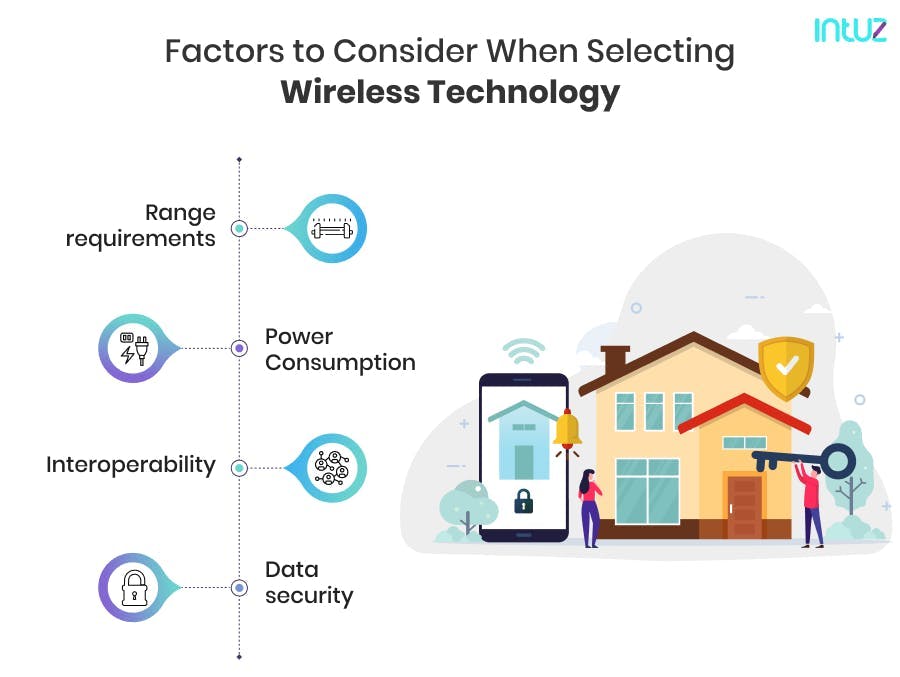
1. Range requirements
The range determines how far the devices can communicate with each other or with a central hub. WiFi typically offers a broader range, making it suitable for devices scattered throughout the home. On the other hand, Zigbee and Z-Wave employ mesh networking to extend the range by allowing devices to act as repeaters, enhancing communication in larger areas.
2. Power consumption
Devices with high power requirements may drain batteries quickly, leading to frequent replacements or recharging. Therefore, evaluate the power consumption of the wireless technology and ensure that it aligns with the energy constraints of the devices. Technologies like Zigbee and Z-Wave are designed to be low-power, making them suitable for battery-operated devices.
3. Interoperability
Some wireless technologies, such as Zigbee and Z-Wave, prioritize interoperability, allowing devices from different brands to communicate and work together seamlessly. WiFi and Bluetooth also offer a wide range of interoperable devices, but checking Matter protocol compatibility is essential.
4. Data security
Security is a critical aspect of smart home devices, as they often handle sensitive information and control access to the home. When evaluating wireless technologies, consider the security features and protocols offered. Matter, for instance, provides robust encryption methods and authentication mechanisms to protect data and prevent unauthorized access.
Hardware components required to build a smart home device with Matter
Smart home devices comprise various components that work together to enable functionality and can vary based on the device’s intended functionality, form factor, and target market.
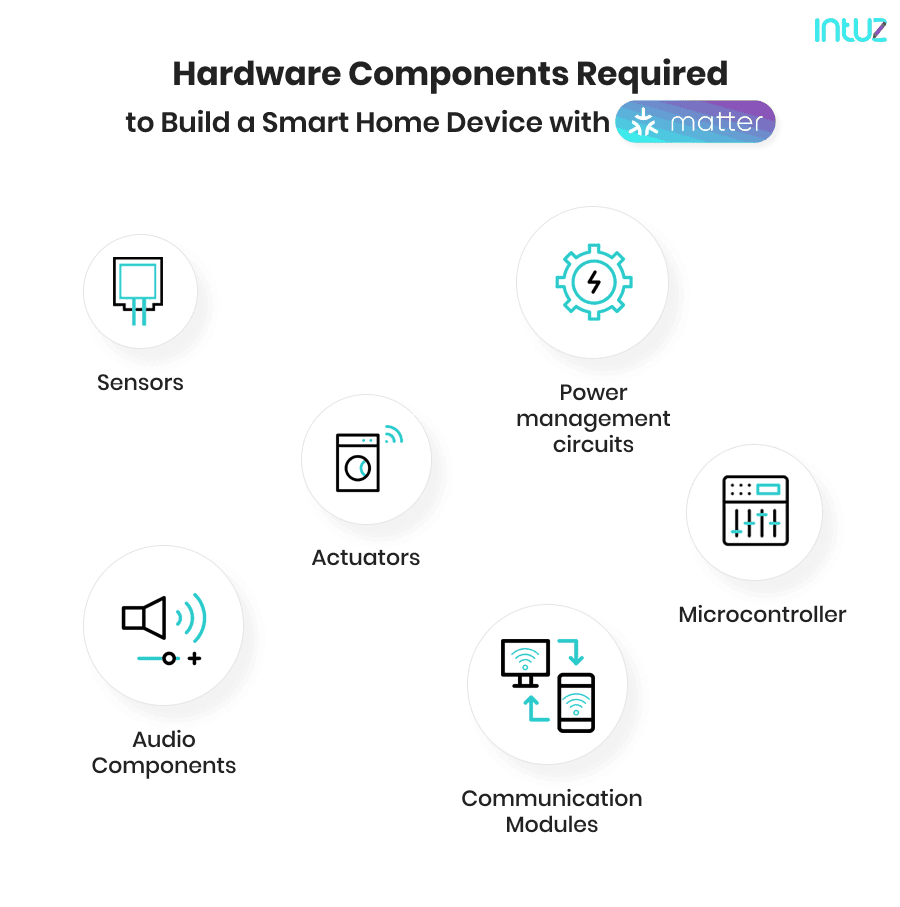
1. Sensors
They collect data from the environment or detect specific conditions in a smart home environment. IoT Sensors provide input that informs the device’s behavior or triggers specific actions. It is vital to identify the specific functionality or purpose of the smart home device and select appropriate sensors or actuators accordingly. For example, if you are building a smart thermostat, you might need temperature and humidity sensors.
2. Actuators
These components enable physical actions or responses based on the commands received from the microcontroller or sensors. Actuators can include motors, relays, solenoids, or even simple switches. They allow devices to turn on/off lights, open/close doors, adjust the temperature, or activate security systems.
3. Microcontroller
The heart of a smart home device is a microcontroller that runs the necessary software and interfaces with other hardware components. It handles data collection, device control, and communication with other components.
Examples of commonly used microcontrollers are the ESP32, nRF52 series, or Silicon Labs EFR32. You will need a microcontroller that supports the required communication protocols for Matter, such as WiFi, Ethernet, or Thread.
4. Audio components
Smart home devices with audio capabilities, such as smart speakers or voice assistants, may require speakers, microphones, or audio processing components to enable voice commands, sound playback, or voice recognition.
5. Communication modules
Such modules enable smart home devices to connect and communicate with other devices or a central hub. They facilitate data exchange, allowing devices to be controlled remotely or to share information with other devices within the smart home ecosystem.
Matter protocol devices typically require wireless connectivity to communicate with other devices and the home network.
Depending on the specific requirements of the device, you might choose WiFi (802.11n/ac), Bluetooth Low Energy (BLE), or Thread (802.15.4) as the primary wireless technology. You will need a connectivity module that supports the chosen wireless protocol.
6. Power management circuits
They are responsible for managing the power supply of smart home devices. Power management circuits regulate voltage levels, control power consumption, and protect against power surges or failures. Examples include voltage regulators, power switches, and battery charging circuits, depending on the device’s specific power requirements.
How to choose the right hardware components for smart home device development
Matter is an open and interoperable smart home connectivity standard, so it is important to select compatible components that can seamlessly integrate with other Matter devices. Here are some key factors to note:
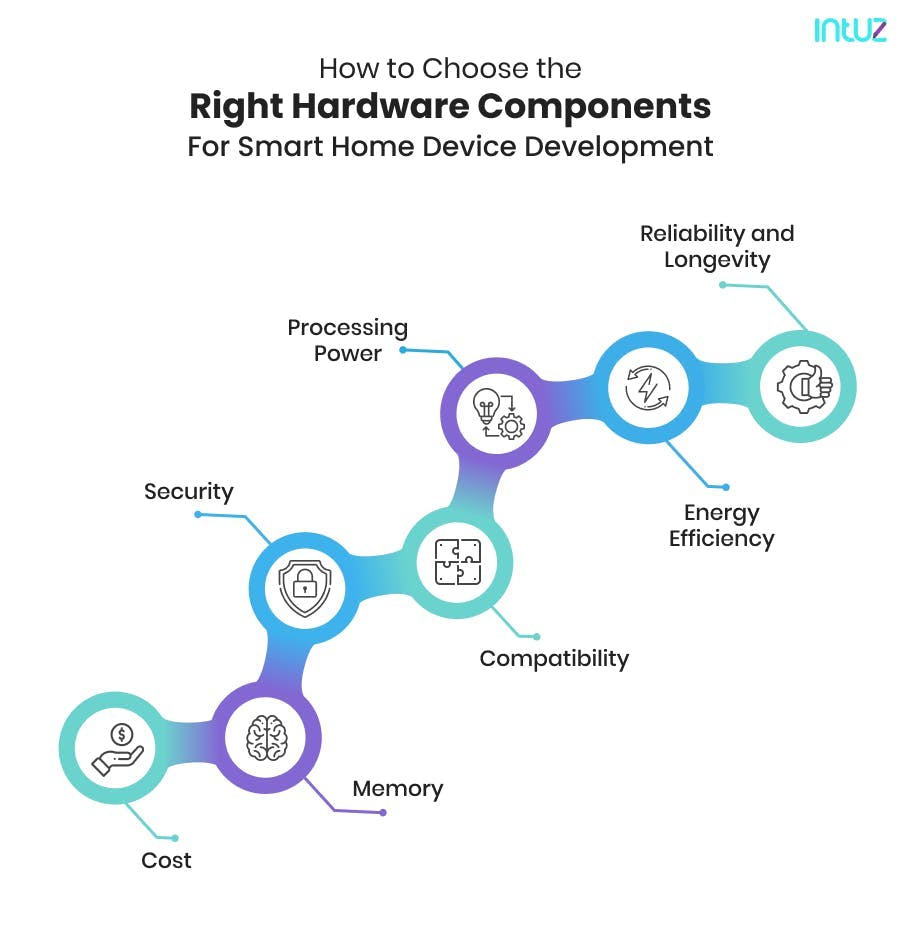
1. Cost
Evaluate the cost-effectiveness of the components while maintaining the desired quality and performance. Ascertain the overall component costs, including upfront expenses and any licensing or royalty fees associated with using specific components. Compare costs among vendors or manufacturers to find the right balance between affordability and quality.
2. Memory
Take note of the memory requirements for storing firmware, data logs, and user configurations. Assess the need for volatile memory (RAM) for temporary data storage and non-volatile memory (flash memory or EEPROM) for permanent storage. Ensure the selected components offer sufficient memory capacity and meet the device’s storage needs.
3. Security
Security is crucial for smart home devices that handle sensitive data or control access to the home. Choose components with robust security features, such as encryption algorithms, secure authentication methods, and secure communication protocols.
Highlight components with built-in security features or compatibility with security modules to enhance data protection and prevent unauthorized access.
4. Compatibility
It is crucial to select components that are compatible with each other and the overall system architecture. They should be able to communicate and interface seamlessly, ensuring proper functionality and integration within the smart home ecosystem.
5. Processing power
Evaluate the processing power requirements of the device based on the intended tasks and complexity of operations. Select microcontrollers or processors with adequate processing capabilities to efficiently handle the required computations and tasks. Consider the clock speed, number of cores, and instruction set architecture to meet the device’s processing demands.
6. Energy efficiency
Energy efficiency is essential for smart home devices, particularly those powered by batteries or designed to conserve energy. Pick components with low power consumption and incorporate power-saving features to extend battery life or reduce overall power usage.
7. Reliability and longevity
Select components from reputable manufacturers with a track record of quality and reliability. Assess factors like component lifespan, availability, and manufacturer support to ensure the longevity and stability of smart home devices. Reliability is crucial for a seamless smart home experience.
Consider the wireless technology’s reliability in signal stability, resistance to interference, and overall performance. Technologies like Zigbee and Z-Wave operate on lower frequencies and are generally less prone to interference from other devices than WiFi or Bluetooth.
Matter vs. Thread: A Guide On Smart Home Technology Standards
Learn MoreHow to use the Matter SDK to develop the software for smart home devices
Using the Matter SDK, developers can integrate the Matter protocol into their smart home devices. This enables seamless communication and interaction with other Matter-enabled devices in the ecosystem.
The SDK provides the necessary tools and resources for creating smart home devices that connect and interact within the Matter ecosystem. Here is how to use the Matter SDK:
1. Get familiar with Matter specifications
To effectively implement the Matter SDK, it is important to understand the concepts, protocols, and standards associated with the Matter protocol. This includes familiarizing yourself with the underlying technologies, such as IPv6, Thread, and WiFi, and the interoperability requirements and device behavior specified by the Matter project.
2. Install the Matter SDK
Obtain the Matter SDK from the official Matter project repository or platform-specific repositories that provide the SDK for your target development environment.
Follow the installation instructions specific to your platform, whether for mobile, embedded systems, or other supported platforms. This will ensure you have the tools and libraries required to integrate Matter support into your project.
3. Study the SDK documentation
Thoroughly review the SDK documentation provided by the Matter project. This documentation will provide detailed information on the SDK’s features, APIs, and guidelines for usage.
You will gain insights into integrating the SDK into your development project and utilizing its functionalities effectively. Understanding the available APIs and their usage will enable you to make the most of the Matter SDK’s capabilities.
4. Implement the Matter protocol
Using the APIs and libraries provided within the Matter SDK, start implementing the necessary code to support the Matter protocol in your project.
This involves device discovery, pairing and authentication, data exchange, and handling device interactions according to the Matter specifications.
By leveraging the APIs and following the guidelines, you can ensure that your implementation aligns with the standardized behavior expected from Matter smart home devices.
5. Test and debug your device
Thoroughly test your implementation to verify that your Matter-enabled device can communicate and interoperate correctly with other Matter devices.
This testing phase should cover various scenarios and edge cases to ensure robustness and compliance with the Matter protocol.
Utilize debugging tools and techniques to identify and resolve any issues or errors that may arise during testing, ensuring that your implementation meets the expected standards of functionality and behavior.
6. Implement necessary security measures
This includes incorporating encryption, authentication, and secure communication protocols to protect user data and maintain the devices’ integrity and interactions. Adhere to the recommended security practices outlined in the Matter specifications to ensure your implementation meets the required security standards.
7. Certify your device as Matter-compatible
This typically involves submitting your device for testing and verification to ensure Matter protocol and standard compliance. By going through the certification process, you can demonstrate that your device meets the requirements for interoperability and compatibility with other Matter devices, enhancing its marketability and credibility.
8. Stay updated with the latest versions of the Matter SDK
As the Matter protocol evolves and improvements are made, new SDK versions may be released to incorporate these changes. It is, therefore, important to keep your software up to date and make any necessary updates or modifications to ensure continued compatibility and functionality with the latest version of the Matter protocol. Regular maintenance and updates will help ensure a smooth user experience and avoid potential compatibility issues.
Deploying security in smart home devices to protect user data
Smart homes can be vulnerable to cyberattacks due to their interconnected nature and the potential security vulnerabilities in smart home devices or networks. One real-life example of a smart home cyberattack is the Mirai botnet attack in 2016.
The Mirai malware infected numerous IoT devices, including smart home devices such as cameras, routers, and DVRs, turning them into a powerful botnet. It exploited default or weak passwords and known vulnerabilities in the devices’ software. With user data and privacy at stake, it is important to implement security protocols.
Security mechanisms supported by Matter
Matter aims to establish a secure and trusted smart home environment. Some of the key security mechanisms supported by Matter include:
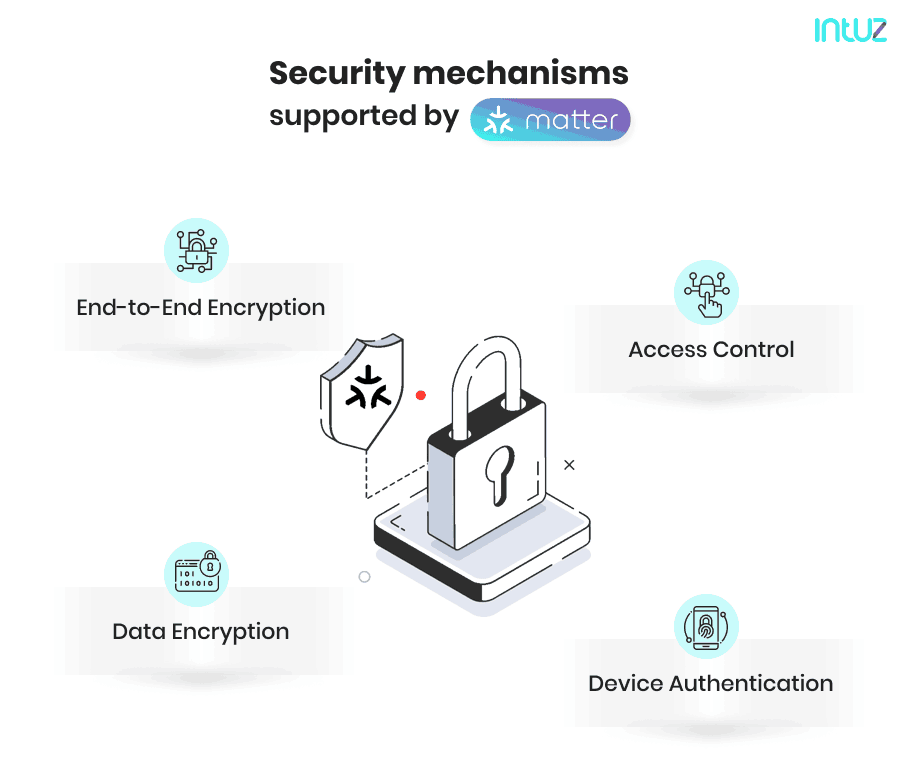
1. End-to-end encryption
It ensures that data exchanged between devices in a smart home ecosystem is encrypted from the sender to the receiver, protecting it from unauthorized access or tampering.
End-to-end encryption encrypts the data at the source device and can only be decrypted by the intended recipient device with the correct decryption keys. This means that even if the data is intercepted during transmission, it remains unintelligible to unauthorized entities.
2. Device authentication
It involves a secure process for verifying the identity of devices within the smart home network. During pairing, devices exchange cryptographic keys or credentials to establish trust and authenticate their identities.
Only authorized and trusted devices can join the network and communicate with others. Device authentication prevents unauthorized devices from gaining access to the smart home system, enhancing the overall security and trustworthiness of the ecosystem.
3. Data encryption
It ensures that sensitive data stored on or transmitted between devices is encrypted, making it unreadable to unauthorized parties. When data is encrypted, it is transformed into an unreadable format using encryption algorithms and encryption keys.
That is how Matter protects sensitive information such as user credentials, personal data, or device configurations, even if unauthorized entities access or intercept them. This safeguards the privacy and confidentiality of data within the smart home ecosystem.
4. Access control
Access control mechanisms provided by the Matter protocol enable the management of permissions and user access to smart home devices and their functionalities. Users can be assigned different roles and access levels, allowing granular control over device operations.
Access control ensures that only authorized individuals, or user accounts can perform specific actions or access certain features.
How Matter Protocol Compares Against Other Smart Home Standards
Learn MoreTesting and certification: Ensuring compliance with Matter’s guidelines
Generally speaking, testing and certifying smart home devices help identify and address potential vulnerabilities and flaws, protects end-users from risks like hacking or malfunctions, and promote a standardized and reliable user experience in an interconnected ecosystem. In the context of Matter, the processes help achieve compliance with its guidelines:
1. Interoperability and compatibility
The Matter protocol aims to establish a unified standard for smart home devices, enabling seamless interoperability and compatibility between different brands and manufacturers.
By undergoing testing and certification, devices can demonstrate their adherence to Matter’s specifications. This ensures that the devices communicate effectively with other Matter-certified devices, enabling a cohesive smart home ecosystem.
2. Ecosystem growth and adoption
Ensuring that devices conform to Matter encourages manufacturers to develop compatible devices, fostering a larger ecosystem of interoperable smart home products. This expands consumer choices and increases the overall adoption of Matter-certified devices.
3. Standard conformance
Matter defines specific standards and guidelines for device behavior, communication, security, and data models. They are evaluated against these standards through testing and certification to verify conformance. This helps ensure they meet the required protocols, data formats, security mechanisms, and overall behavior defined by the Matter protocol.
4. Security assurance
Testing and certification processes validate that smart home devices meet the prescribed security measures, including encryption, authentication, and access controls.
By undergoing rigorous security testing, devices can demonstrate their ability to protect user data and maintain the integrity of the smart home system.
Challenges and solutions for building smart home devices with Matter
Despite the abundance of benefits and use cases the Matter protocol brings, it is also important to understand its limitations and how they can be overcome. Let us take a look:
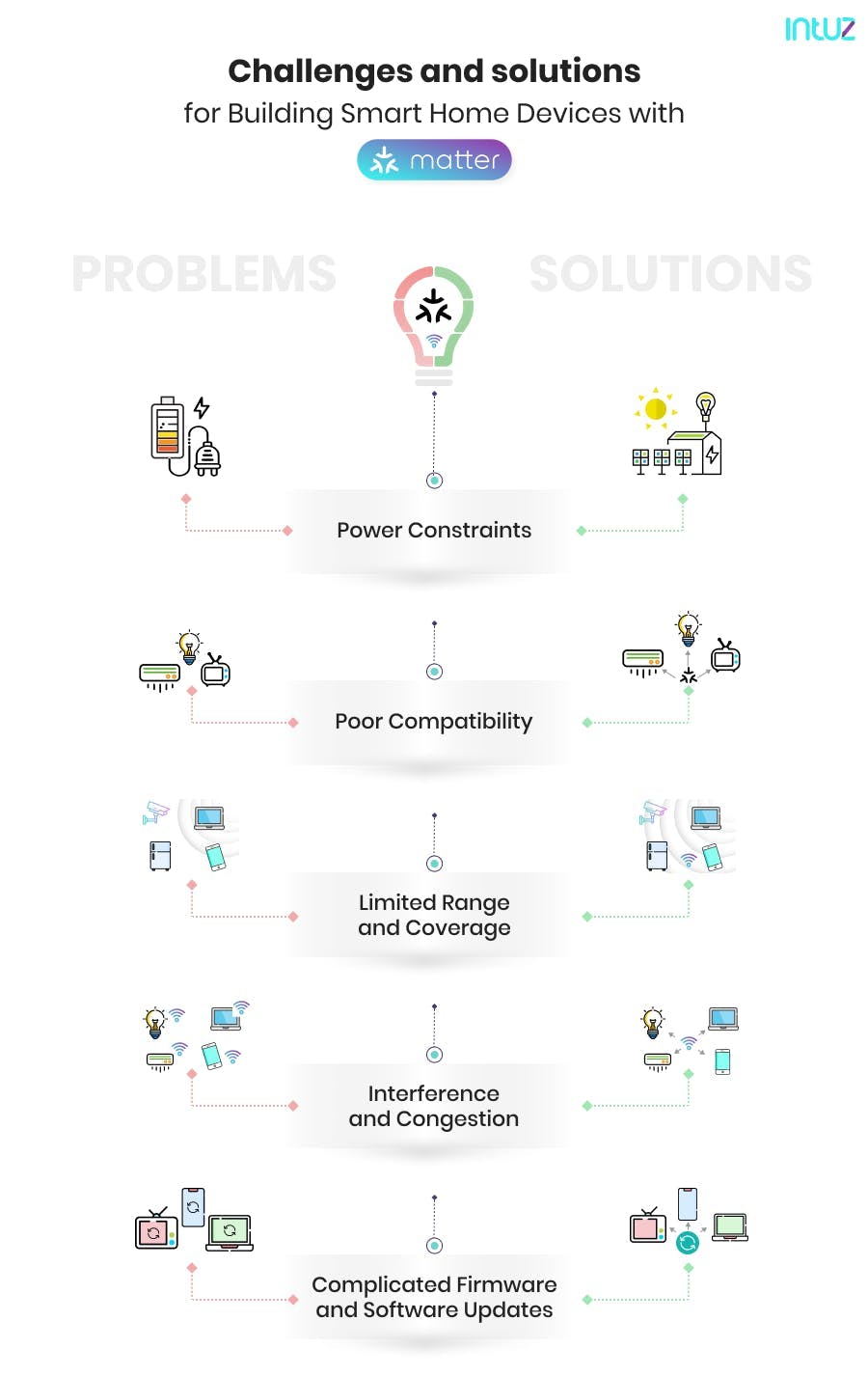
1. Power constraints
Balancing power consumption with the desired functionality and responsiveness can be a challenge. Optimize device firmware and software to minimize power consumption.
Use efficient protocols and algorithms to reduce the frequency and duration of wireless transmissions. To extend battery life, provide power-saving features, such as sleep modes or motion-triggered activations.
2. Poor compatibility
Different wireless technologies may have varying compatibility requirements or limitations. For example, some devices may support WiFi, while others may use Zigbee or Thread. Ensuring seamless interoperability between these technologies can be a challenge.
Use a smart home hub or bridge that supports multiple wireless technologies. This can be a central hub to connect and control devices using different protocols. Ensure the devices you choose explicitly support the Matter protocol and are certified as Matter-compliant.
3. Limited range and coverage
Different wireless technologies have different range capabilities. WiFi typically has a longer range than Zigbee or Bluetooth, impacting device connectivity and coverage within the smart home. Opt for devices that use mesh networking protocols like Zigbee or Thread, which can create a network of devices to extend coverage and enhance connectivity.
4. Interference and congestion
This can be an issue, particularly in densely populated areas or environments with many wireless devices, affecting the reliability and performance of smart home devices. Therefore, choose wireless channels that are less congested.
For example, WiFi routers can be set to use less crowded channels to minimize interference. Optimize the placement of devices to minimize signal interference. Keep devices away from potential sources of interference, such as microwaves or cordless phones.
5. Complicated firmware and software updates
This can be a problem, especially if devices are from different manufacturers. Therefore, choose devices that support over-the-air (OTA) updates. This allows manufacturers to push updates and patches wirelessly, ensuring that devices stay up-to-date with the latest features and security fixes. Consider using a central smart home management platform that can handle updates for multiple devices and protocols, providing a unified and simplified update process.
How developments in Matter can influence the future trends smart home ecosystem
Overall, the developments in Matter are expected to foster a more accessible, secure, and integrated smart home ecosystem. It has the potential to shape the future of connected living through the following:
1. Enhancing interoperability
Matter aims to establish a unified standard for smart home connectivity, enabling devices from different manufacturers to seamlessly communicate and work together.
This increased interoperability will increase users’ convenience, as they can mix and match devices from various brands without worrying about compatibility issues.
It will also foster a more diverse and competitive market, driving innovation and offering consumers a wider range of choices.
2. Simplifying setup and configuration
With Matter-certified devices, users can expect a more straightforward and intuitive setup process, reducing the complexity of connecting and managing smart home devices. This will help broaden the adoption of smart home technology among users whose perceived complexity might have deterred it.
3. Boosting integration with 5G and edge computing
The rollout of 5G networks and the advancements in edge computing will enable faster and more reliable connectivity for smart home devices.
With lower latency and higher bandwidth, 5G connectivity can support real-time interactions and enable more sophisticated applications in the smart home.
Edge computing, where data processing occurs closer to the devices than the cloud, can enhance responsiveness and privacy, allowing smart home devices to operate locally and reducing dependence on constant internet connectivity.
Over to you
With its support for multiple wireless technologies and a strong focus on security and privacy, Matter has the potential to revolutionize the smart home market.
Developers now have the opportunity to leverage the protocol to create and customize smart home devices that cater to specific application requirements. This ensures a more consistent and reliable smart home experience and bolsters robust security and privacy measures.
If you want expert advice regarding Matter smart home automation or are interested in developing an IoT product, contact our knowledgeable team at Intuz. Book a free consultation today!


